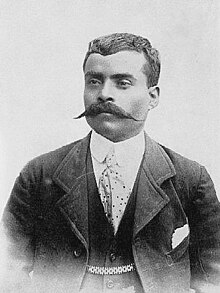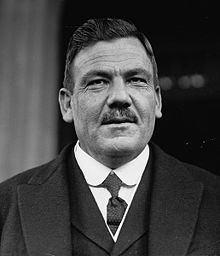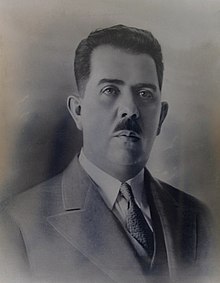The Mexican Revolution (1910-1917) was actually a series of civil wars fought between a diverse group of men with widely disparate histories and motivations. The war and its aftermath can be divided into five stages or chapters, each consisting of a number of critical episodes:
- Dictator Porfirio Díaz Triggers a Revolution
- Short and Tragic Presidency of Francisco Madero
- Battle Against Victoriano Huerta
- Venustiano Carranza Wins Against Pancho Villa and Emiliano Zapata
- Post-War Power Struggles: The End of Almost Everyone
The Protagonists and Antagonists:
Since the story is, as Mexicans would say,
complejo y complicado, complex and complicated, with many key
personajes, actors who, at times, switch from being protagonists to antagonists, it helps to meet them in advance. They are introduced here in the order they enter the story:
 |
Porfirio Díaz
Photo: Wikipedia |
Porfirio Díaz: Born Sept. 15, 1830, into a working class,
mestizo (mixed indigenous-Spanish) family in Oaxaca (southern Mexico). Fought on the side of the liberals and the government of
Benito Juárez against Conservatives in the
War of Reform (1857-61) and the
French Intervention (1861-67). Rebelled unsuccessfully against Juárez after he lost against the president in the election of 1870. Rebelled successfully against Juárez's successor, Sebastian Lerdo, in 1876. President of Mexico, 1876 to 1911, epoch known as the
Porfiriato. In 1908, at age 78, he announced that he might not run for president in 1910 and Mexico was ready for a democratic competition of candidates.
 |
Francisco Madero
Photo: Wikipedia |
Francisco Madero: Born Oct. 30, 1873, the eldest son of a wealthy Coahuila family (northern Mexico). Studied in France and the U.S. Adopted liberal ideas. Became politically active after
Bernardo Reyes, governor of neighboring Nuevo León, crushed a protest against Díaz in 1903. When Díaz announced he was open to a competitive election, Madero wrote a book,
The Presidential Succession of 1910, in which he proclaimed that the concentration of absolute power in the hands of one man had brought a dramatic loss of freedom. He proposed organizing a political party under the slogan
"Valid Voting, No Re-election".
Presidential candidate of Anti-Re-electionist Party, Madero was arrested by Díaz. In jail, he wrote a call to Revolution. Escaping, he fled to the U.S. and called for the Revolution to begin Nov. 20, 1910. After the defeat of Díaz in 1911, Madero became President.
 |
Pascual Orozco
Photo: Wikipedia |
Pascual Orozco: Born Jan. 28, 1882, he was a wealthy mine owner in west-central Chihuahua (northern Mexico). Responding to Madero's call, he took leadership of irregular forces in Nov. 1910 and began attacking Federal Forces. He was immediately successful, taking control within two months of most of Chihuahua. After Díaz resigned in 1911, he rebelled against President Madero.
 |
Francisco "Pancho" Villa
Photo: Wikipedia |
Francisco "Pancho" Villa: Born June 5, 1878, José Doroteo Arango Arámbula took the name Francisco Villa as an adult. He was the son of indigenous peons working on a
hacienda, a large estate, in the state of Durango (northwestern Mexico). Uneducated, Villa worked at various laborer jobs but became an outlaw and bandit, evidently after killing a hacienda owner he said had raped his sister. At one point, he was conscripted into the federal army, but soon deserted. When the revolt against Díaz broke out, Villa joined Orozco's forces and immediately demonstrated remarkable natural tactical military abilities.
 |
Emiliano Zapata
Photo: Wikipedia |
Emiliano Zapata: Born Aug. 8, 1979, in the rural village of Anenecuilco in the State of Morelos (south of Mexico City); his parents were
mestizo campesinos, partly indigenous, small farmers. When his father died, the sixteen year-old Emilino became responsible for the care of his family. When the leader of the village council announced in 1909 that he was resigning because of his age, a community assembly elected Zapata. He began negotiating with State authorites of the Porfirian government over numerous land title disputes between poor indigenous farmers and wealthy hacienda owners. His efforts were met with opposition. Zapata then began to organize armed takeovers of disputed land. When the Revolution exploded in the north, Zapata and his forces began direct attacks on federal forces in Morelos.
 |
Victoriano Huerta
Photo: Wikipedia |
Victoriano Huerta: Born Dec. 22, 1850, of indigenous Huichol parents in Jalisco (western Mexico). First obtaining work with an army general in the area, he was subsequently admitted (1892) to the National Military Academy. He engaged in several expeditions to put down indigenous rebellions in various states and was promoted to brigadier general. In 1907, he retired due to cataracts affecting his performance. When the Revolution began, he was accepted back into the Army. When Díaz resigned as President, Huerta swore loyalty to President Madero. In February 1913, he changed his mind and managed Madero's overthrow.
 |
Álvaro Obregón
Photo: Wikipedia |
Álvaro Obregón: Born Feb. 19, 1880, into a once-wealthy landowning family the northern state of Sonora. The family's lands were confiscated because the family had sided with the French invasion against Benito Juárez's liberal govenment. Obregón worked as a small farmer and gained some success as inventor of a chickpea harvester. He joined the irregular forces supporting Madero against Orozco's revolt and immediately demonstrated natural military genius, winning several battles. When Huerta seized power, he led Sonora forces in joining the "Constitutional Army". He then became the chief general of Venustino Carranza.
 |
Venustiano Carranza
Photo: Wikipedia |
Venustiano Carranza; Born Dec. 29, 1859, was a well-to-do cattle rancher and rising politician in the state of Coahuila, bordering Texas. During the Porfiriato, he had been a municipal president and, with the support of Bernardo Reyes, governor of neighboring Nuevo León, he became first a state legislator then federal senator. In 1909, he sought to be governor, but Díaz didn't select him. In 1910, he then supported Madero's candidacy against Díaz. When Madero became president, he appointed Carranza governor of Coahuila. When Huerta seized power in 1913, Carranza had his state legislature declare the state in rebellion and, with governors in Sonora and other northern states, he organized the "Constitutional Army", declaring himself "
primer jefe", first chief.
 |
Plutarco Elías Calles
Photo: Wikipedia
|
Plutarco Elías Calles: Born September 25, 1877, in Sonora. Plutarco Elías Lucero was the "natural child" of unmarried parents. His father was an alcoholic, apparently from a family that had lost its wealth. His mother died when he was young, and he was raised by his mother's sister and her husband, Juan Bautista Calles. Plutarco took Calles as his family name. He supported Francisco I. Madero and became a police commissioner. Joining the Constitutional Army in 1913, he attained the rank of general in 1915. He was a leader of the Constitutional Army in Sonora, together with Obregón, and defeated Pancho Villa in the Battle of Agua Prieta in 1915. He then became governor of Sonora.
 |
Lázaro Cárdenas
Photo; Wikipedia |
Lázaro Cárdenas del Río: Born May 21, 1895, one of eight children in a
mestizo family in Jiquilpan, Michoacán (west-central Mexico), where his father owned a billiard hall. Upon the death of his father, Cárdenas at the age of 16 was his family's sole support. He worked as a tax collector, printer's devil, and jailkeeper. He had set his sights on becoming a teacher, but was drawn into the military after Victoriano Huerta overthrew President Francisco Madero in February 1913. At the age of 18, Cárdenas joined the Zapatistas, but Huerta's forces scattered the group. He escaped and moved north to serve with Álvaro Obregón and then Pancho Villa. When Villa was defeated by Obregón, Cárdenas joined the forces of Plutarco Elías Calles, who sent him on operations against Yaqui indigenous in Sonora and Zapatistas in Michoacán and Jalisco. He rose to a field command as general. In 1920, Cárdenas was appointed provisional governor of his home state of Michoacan.










No comments:
Post a Comment